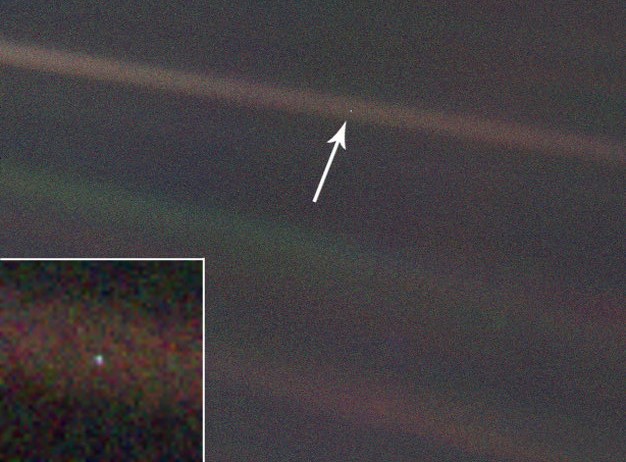5 facts about the planet Earth. Quick Reference
Earth, Terra, Earth, Erde, all peoples differently call the same world in which we all live. Having visited all the known worlds of the solar system, we sincerely began to understand how unique our own world is. In this review, I will introduce you to little-known facts about the unique physical and climatic features of our stone giant that determined our very existence.
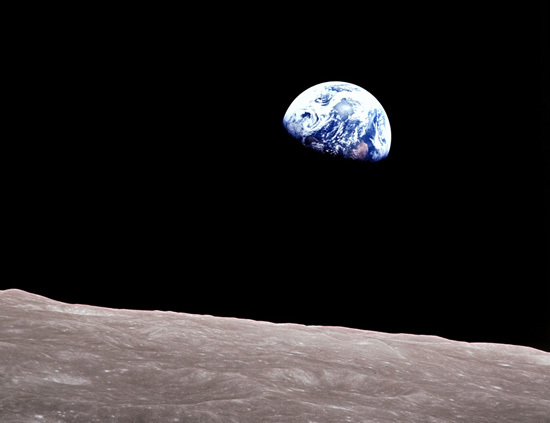
We all know the main features of our planet that we have not yet been able to observe on other planets - namely, the oceans of liquid water on the surface and of course the existence of life. However, many will be interested to learn about the other unique features of our planet, thanks to which the existence and evolution of life on it became possible.
Ironstone giant
')
Planet Earth is not only the largest of the stony planets of the solar system, but also the most massive (larger in the solar system, does not always mean massive). The mass of the Earth is estimated at 5.97 x 10 24 kg, while the mass of its "sister" of Venus is 1.1 x 10 24 kg less. To increase the mass of Venus to the mass of the Earth, we would not even have enough of all the material of Mercury, Mars and the Moon together (5.8610 24 kg in total). And only by adding to this planetary “salad” Ganymede, the largest and most massive satellite of the planet in the solar system (Jupiter), could we “outweigh” the stone giant. And then only by ½%.
The largest "stone" planets and satellites of the solar system
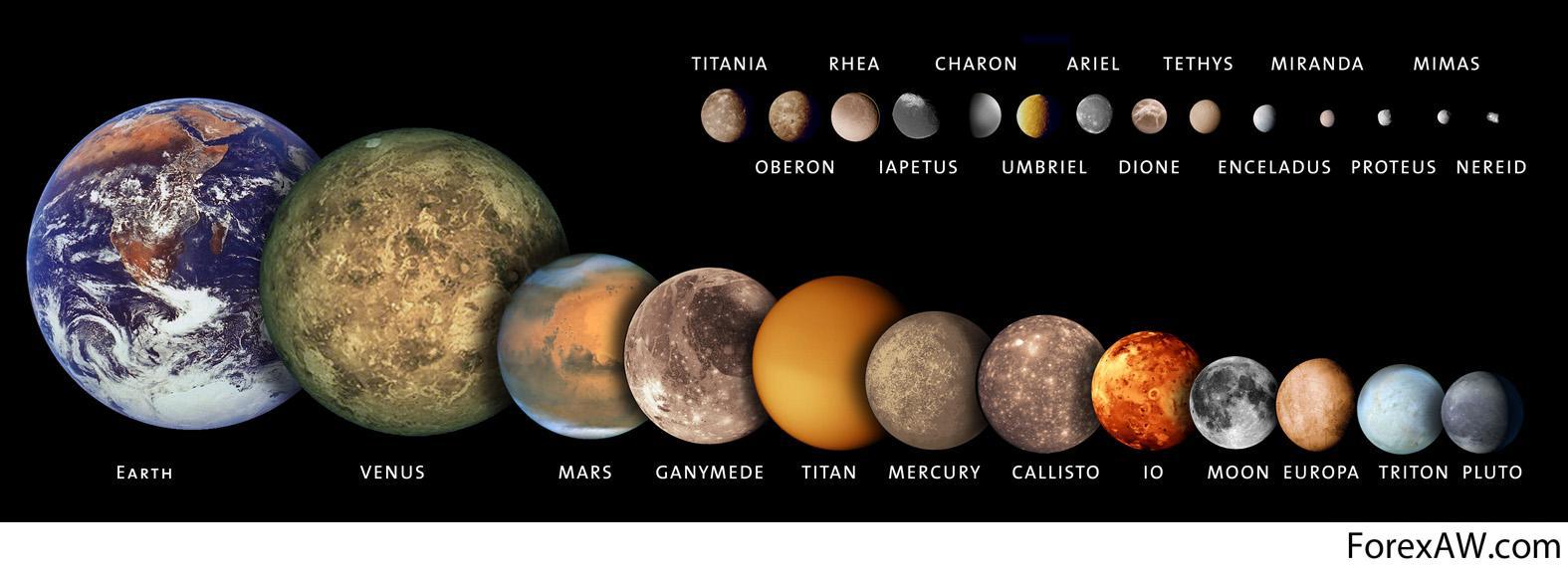
A similar mass difference is also achieved by the fact that the Earth is also the densest planet of the solar system (5.51 g / cm 3 ). The acceleration of free fall (g) at its equator is similar to that at the level of the imaginary surface of most of the giant planets (with the exception of Jupiter, where g is 2.5 times as large).
Natural nuclear reactor
Practically all lovers of physics and related sciences (such as astrophysics) are well acquainted with energy sources in stars like the sun, where the thermonuclear fusion of hydrogen and helium nuclei takes place. Active processes of "production" and energy transfer occur inside large planets, but at the expense of diametrically opposite processes.
During the formation of our planet, the heaviest and densest elements, such as iron, nickel, and radioactive isotopes, descended to the center of the planet, while the lightest remained closer to the surface. Thus, there was a differentiation of the inner layers of the planet. Therefore, large celestial bodies are distinguished by the relative scarcity of heavy elements near their surface (one of the main reasons for the interest of earthlings to Mars). As a result, in the center of the planet, an iron-nickel core was formed, heated by the decay of radioactive elements to 5700 ° C.
Nedra of the Earth: 1-2 Internal and external core (total mass of 28.5 mass of the Moon); 3 mantle (52 mass of the moon). The Earth's lithosphere (4), together with the hydrosphere and atmosphere, is no more than 1/3000 the mass of the planet
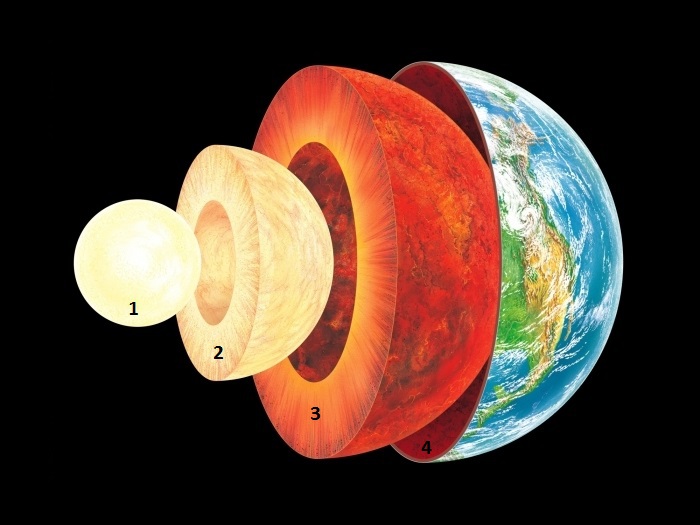
All this heat is transferred through the liquid outer shell and passes into the mantle. The actual motion of the molten metal in the outer core generates the Earth’s magnetic field. Through convection processes in the mantle, energy reaches the crust of the Earth - the continental drift known to us is the result of constant movements of lithospheric plates forming the crust.
Those. The Earth is not just a giant boulder, active only at the surface, but a colossal nuclear reactor, with active heat release systems and powerful magnetic field generators.
Magnetic shield
The above mentioned magnetic field of the Earth is also not typical for the terrestrial planets. More precisely, a magnetic field of a similar nature was also found in Mercury, but the Earth’s magnetosphere is more like a giant planet’s magnetosphere in its characteristics. In terms of its intensity at the equator, it is only inferior to Jupiter (10 times), surpasses Saturn with Uranus and is comparable to the magnetic field of Neptune (0.3 Gs at the equator). However, in terms of the size of the magnetosphere and the dipole magnetic moment, it is significantly inferior to them all.
The scheme of the magnetic field of the Earth. The ionosphere appears when the molecules of the upper layers of the atmosphere are ionized by solar radiation. It is present in almost all planets with relatively dense atmospheres and can deflect part of the charged particles arriving from the surface of the Sun.
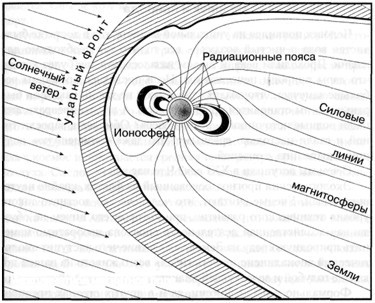
In contrast to the magnetospheres of the planets of the giants, the magnetic poles of the Earth do not correspond to the geographical, the north magnetic pole of our planet is located in the southern hemisphere, and the south, respectively, in the northern hemisphere. The reasons for such a geographical location of the magnetic poles lie in their permanent inversions on geological time scales (associated with chaotic processes in the liquid outer core of the planet). Magnetic poles, traveling on the surface of the Earth, are alternately approaching the geographic poles of the planet. The whole process takes from 1,000 to 10,000 years, during which “polar” auroras at certain periods can be observed at any latitude of the planet, up to the equator. During such inversions, the magnetic field of the planet temporarily weakens, which can lead to an increase in the radiation background on the Earth's surface. Currently, the magnetic poles "travel" around the planet with an ever-increasing speed - more than 50km / year in our days.
Inversion of the magnetic poles of the Earth over the past 5 million years. Black color indicates inversions similar to modern ones. White color - periods of reversion (magnetic poles lie in the appropriate geographic)

Scientists do not have data on the positive correlation of the weakening of the magnetic field during its inversion with the mass extinction of species. However, in any case, such a weakening of the Earth’s “magnetic shield” will not surprise humanity:
Stability month
If chaotic processes in the Earth’s core cannot guarantee a stable orientation of the dipoles of the Earth’s magnetic field, the natural satellite of our planet for 4.5 billion years provides a stable orientation of its geographic poles relative to its orbital plane of revolution around the Sun at an angle of 23.5 ° (changing within 3 ° with a period of 100,000 years). Such stability of the axis of rotation of the planet is capital to ensure relatively constant conditions for the evolution of life on our planet. For example, the planets Venus or Mars are doomed to randomly change the angle of inclination of the axis of rotation to the plane of revolution, under the influence of the tidal forces of the major planets and the sun. However, the axis of rotation of the Earth is subject to the so-called precession .
The existence of such a heavy "stabilizer" in the orbit of our iron-stone giant also brings him closer to the gas and ice giants. The moon has a transverse diameter of 3476 km and is the fifth largest satellite in the solar system (after the largest satellites of Jupiter and Saturn). His matter would easily have been enough for 5 planetoids with a mass of Pluto, and the rest is enough for two more asteroid belts between the orbits of Mars and Jupiter!
Relative dimensions of Earth, Moon and Pluto

The Earth-Moon system has the smallest mass ratio of the planet and its satellite in the solar system (previously owned by the Pluto-Charon system), the Earth surpasses the Moon "only" in this respect by 81 times. For example, Saturn surpasses Titan in mass by almost 3000 times!
A mote-sized universe ...
A large mass of the Earth in combination with a powerful magnetic field and a large natural satellite made a major contribution to the climatic diversity of our planet. Many people remember how heroes in fantastic sagas traveled to various worlds in which only a certain type of climate dominated. These are the rocky planets Vulcan from Star Trek, the hot Tatooine, the frozen Hut and the forest satellite of the giant Endor in the Star Wars. Of course, this is only a simplification of the authors, and populated planets can show great climatic diversity, as on Earth. On our iron-stone giant there is a place for a whole universe of various landscapes - for endless oceans, and for impassable forests with jungles and, of course, for the endless dazzling icy surface of the poles.
On this final (but not the last), amazing and unique feature of our planet, I would like to finish this brief review. However, it would be more correct to give the floor to Karl Sagan, who left us long ago, but left a substantial intellectual legacy:
My publications are close to the topic:
Extreme sister of the Earth. The Past and Future of the Morning Star
Earth rise on the moon ... common
What killed the "terrible lizards"? About mass extinction generators

We all know the main features of our planet that we have not yet been able to observe on other planets - namely, the oceans of liquid water on the surface and of course the existence of life. However, many will be interested to learn about the other unique features of our planet, thanks to which the existence and evolution of life on it became possible.
Ironstone giant
')
Planet Earth is not only the largest of the stony planets of the solar system, but also the most massive (larger in the solar system, does not always mean massive). The mass of the Earth is estimated at 5.97 x 10 24 kg, while the mass of its "sister" of Venus is 1.1 x 10 24 kg less. To increase the mass of Venus to the mass of the Earth, we would not even have enough of all the material of Mercury, Mars and the Moon together (5.8610 24 kg in total). And only by adding to this planetary “salad” Ganymede, the largest and most massive satellite of the planet in the solar system (Jupiter), could we “outweigh” the stone giant. And then only by ½%.
The largest "stone" planets and satellites of the solar system

A similar mass difference is also achieved by the fact that the Earth is also the densest planet of the solar system (5.51 g / cm 3 ). The acceleration of free fall (g) at its equator is similar to that at the level of the imaginary surface of most of the giant planets (with the exception of Jupiter, where g is 2.5 times as large).
By the way, the principle “larger does not mean more massive”: Ganymede is twice as massive as the Moon, and its diameter is 8% larger than that of the planet Mercury (5300km versus 4900km), but it is more than twice as slow as the last!
Natural nuclear reactor
Practically all lovers of physics and related sciences (such as astrophysics) are well acquainted with energy sources in stars like the sun, where the thermonuclear fusion of hydrogen and helium nuclei takes place. Active processes of "production" and energy transfer occur inside large planets, but at the expense of diametrically opposite processes.
During the formation of our planet, the heaviest and densest elements, such as iron, nickel, and radioactive isotopes, descended to the center of the planet, while the lightest remained closer to the surface. Thus, there was a differentiation of the inner layers of the planet. Therefore, large celestial bodies are distinguished by the relative scarcity of heavy elements near their surface (one of the main reasons for the interest of earthlings to Mars). As a result, in the center of the planet, an iron-nickel core was formed, heated by the decay of radioactive elements to 5700 ° C.
Nedra of the Earth: 1-2 Internal and external core (total mass of 28.5 mass of the Moon); 3 mantle (52 mass of the moon). The Earth's lithosphere (4), together with the hydrosphere and atmosphere, is no more than 1/3000 the mass of the planet

All this heat is transferred through the liquid outer shell and passes into the mantle. The actual motion of the molten metal in the outer core generates the Earth’s magnetic field. Through convection processes in the mantle, energy reaches the crust of the Earth - the continental drift known to us is the result of constant movements of lithospheric plates forming the crust.
Those. The Earth is not just a giant boulder, active only at the surface, but a colossal nuclear reactor, with active heat release systems and powerful magnetic field generators.
Magnetic shield
The above mentioned magnetic field of the Earth is also not typical for the terrestrial planets. More precisely, a magnetic field of a similar nature was also found in Mercury, but the Earth’s magnetosphere is more like a giant planet’s magnetosphere in its characteristics. In terms of its intensity at the equator, it is only inferior to Jupiter (10 times), surpasses Saturn with Uranus and is comparable to the magnetic field of Neptune (0.3 Gs at the equator). However, in terms of the size of the magnetosphere and the dipole magnetic moment, it is significantly inferior to them all.
The scheme of the magnetic field of the Earth. The ionosphere appears when the molecules of the upper layers of the atmosphere are ionized by solar radiation. It is present in almost all planets with relatively dense atmospheres and can deflect part of the charged particles arriving from the surface of the Sun.

The magnetic field strength (Gauss) expresses the force with which this field acts on charged particles.
In contrast to the magnetospheres of the planets of the giants, the magnetic poles of the Earth do not correspond to the geographical, the north magnetic pole of our planet is located in the southern hemisphere, and the south, respectively, in the northern hemisphere. The reasons for such a geographical location of the magnetic poles lie in their permanent inversions on geological time scales (associated with chaotic processes in the liquid outer core of the planet). Magnetic poles, traveling on the surface of the Earth, are alternately approaching the geographic poles of the planet. The whole process takes from 1,000 to 10,000 years, during which “polar” auroras at certain periods can be observed at any latitude of the planet, up to the equator. During such inversions, the magnetic field of the planet temporarily weakens, which can lead to an increase in the radiation background on the Earth's surface. Currently, the magnetic poles "travel" around the planet with an ever-increasing speed - more than 50km / year in our days.
Inversion of the magnetic poles of the Earth over the past 5 million years. Black color indicates inversions similar to modern ones. White color - periods of reversion (magnetic poles lie in the appropriate geographic)

Scientists do not have data on the positive correlation of the weakening of the magnetic field during its inversion with the mass extinction of species. However, in any case, such a weakening of the Earth’s “magnetic shield” will not surprise humanity:
“The last time the inversion of the magnetic field occurred about 780 thousand years ago. If homo sapiens appeared 240 thousand years ago, this means that our species has never experienced geomagnetic inversions. At the same time, most scientists agree that the process itself from the beginning to the end takes several thousand years - from 2-3 to 7-10 thousand years. In this case, however, the most active stage can occur within a thousand-year time interval. On the other hand, some experts believe that some of the polarity reversals in the history of the Earth could have lasted tens of thousands of years. In any case, these are not years or decades. ”
(c) The most popular scenarios for the end of the world in December 2012.
Stability month
If chaotic processes in the Earth’s core cannot guarantee a stable orientation of the dipoles of the Earth’s magnetic field, the natural satellite of our planet for 4.5 billion years provides a stable orientation of its geographic poles relative to its orbital plane of revolution around the Sun at an angle of 23.5 ° (changing within 3 ° with a period of 100,000 years). Such stability of the axis of rotation of the planet is capital to ensure relatively constant conditions for the evolution of life on our planet. For example, the planets Venus or Mars are doomed to randomly change the angle of inclination of the axis of rotation to the plane of revolution, under the influence of the tidal forces of the major planets and the sun. However, the axis of rotation of the Earth is subject to the so-called precession .
The rotation of a celestial body is characterized by its movement around its own axis of rotation, while the revolution expresses the actual motion of one celestial body in an orbit around another celestial body. Thus, the Earth does not rotate around the sun, but turns for 365 daily rotations of the Earth.
The existence of such a heavy "stabilizer" in the orbit of our iron-stone giant also brings him closer to the gas and ice giants. The moon has a transverse diameter of 3476 km and is the fifth largest satellite in the solar system (after the largest satellites of Jupiter and Saturn). His matter would easily have been enough for 5 planetoids with a mass of Pluto, and the rest is enough for two more asteroid belts between the orbits of Mars and Jupiter!
Relative dimensions of Earth, Moon and Pluto

The Earth-Moon system has the smallest mass ratio of the planet and its satellite in the solar system (previously owned by the Pluto-Charon system), the Earth surpasses the Moon "only" in this respect by 81 times. For example, Saturn surpasses Titan in mass by almost 3000 times!
A mote-sized universe ...
A large mass of the Earth in combination with a powerful magnetic field and a large natural satellite made a major contribution to the climatic diversity of our planet. Many people remember how heroes in fantastic sagas traveled to various worlds in which only a certain type of climate dominated. These are the rocky planets Vulcan from Star Trek, the hot Tatooine, the frozen Hut and the forest satellite of the giant Endor in the Star Wars. Of course, this is only a simplification of the authors, and populated planets can show great climatic diversity, as on Earth. On our iron-stone giant there is a place for a whole universe of various landscapes - for endless oceans, and for impassable forests with jungles and, of course, for the endless dazzling icy surface of the poles.
On this final (but not the last), amazing and unique feature of our planet, I would like to finish this brief review. However, it would be more correct to give the floor to Karl Sagan, who left us long ago, but left a substantial intellectual legacy:
“Take another look at this point. It's here. This is our house. This is us. Everyone you love, everyone you know, everything you have ever heard of, everyone who ever existed lived their lives on it. Many of our pleasures and sufferings, thousands of self-confident religions, ideologies and economic doctrines, every hunter and gatherer, every hero and coward, every creator and destroyer of civilizations, every king and peasant, every couple in love, every mother and father, every capable child, the inventor and traveler, every teacher of ethics, every deceitful politician, every "superstar", every "greatest leader", every saint and sinner in the history of our species lived here - on a mote suspended in the sunbeam.
Voyager 1, 1990, distance - 6 billion km
The Earth is a very small stage on the boundless space arena. Think of the rivers of blood shed by all these generals and emperors, so that, in glory and triumph, they may become short-term masters of a piece of grain. Think of the endless cruelties perpetrated by the inhabitants of one corner of this point over the barely distinguishable inhabitants of another corner. About how frequent the differences between them, about how they crave to kill each other, about how hot their hatred.
Our posturing, our imaginary significance, the illusion of our privileged status in the universe - they all succumb to this point of pale light. Our planet is just a single speck of dust in the surrounding cosmic darkness. In this great emptiness there is not a hint that someone will come to our aid in order to save us from our ignorance.
Earth is the only known world that can sustain life. We have nowhere else to go - at least in the near future. Visit - yes. Colonize - not yet. Whether you like it or not - Earth is now our home.
Astronomy is said to instill modesty and strengthen character. Probably there is no better demonstration of stupid human ignorance than this detached picture of our tiny world. It seems to me that she emphasizes our responsibility, our duty to be kinder with each other, to keep and cherish the pale blue dot is our only home. ”
- Pale blue dot
My publications are close to the topic:
Extreme sister of the Earth. The Past and Future of the Morning Star
Earth rise on the moon ... common
What killed the "terrible lizards"? About mass extinction generators
Source: https://habr.com/ru/post/366213/
All Articles
